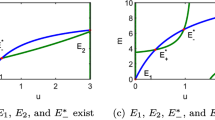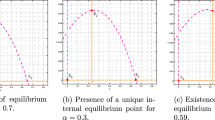Abstract
The act of deliberately removing a body part–called autotomy–is a behavior that has appeared frequently across the tree of life. Though there are many possible functions for this behavior, it is often thought of first as a mechanism to escape predation. In a predator–prey interaction, autotomy can therefore confer significant benefits to the prey–particularly, the benefit of not being eaten–but it may also incur significant costs, including the energy expenditure required to regrow the body part and any additional consequences of losing the body part in the first place. In addition, the presence of autotomy may affect how predators choose to approach prey. Here, we put these costs and benefits into a game theory framework and analyze the evolutionary, ecological, and eco-evolutionary dynamics of autotomy, considering both predator and prey strategies. We also apply our model to an empirical example using existing data from porcelain crabs. We find a wide range of effects of autotomy on the ecological and evolutionary dynamics of the predators and prey, including the possibility that the prey become locked into performing autotomy by the predators and the possibility that autotomy can rescue predator–prey coexistence.






Similar content being viewed by others
References
Abrams PA (1986) Is predator-prey coevolution an arms race? Trends Ecol Evol 1(4):108–110
Abrams PA (2000) The evolution of predator-prey interactions: theory and evidence. Annu Rev Ecol Syst 31(1):79–105
Bateman P, Fleming P (2009) To cut a long tail short: a review of lizard caudal autotomy studies carried out over the last 20 years. J Zool 277(1):1–14
Berryman AA (1992) The orgins and evolution of predator-prey theory. Ecology 73(5):1530–1535
Blumstein DT (2006) The multipredator hypothesis and the evolutionary persistence of antipredator behavior. Ethology 112(3):209–217
Caro T (2005) Antipredator defenses in birds and mammals. University of Chicago Press
Cooper WE Jr (1998) Conditions favoring anticipatory and reactive displays deflecting predatory attack. Behav Ecol 9(6):598–604
Cooper WE Jr, Frederick WG (2007) Optimal flight initiation distance. J Theor Biol 244(1):59–67
Cooper WE Jr, Frederick WG (2010) Predator lethality, optimal escape behavior, and autotomy. Behav Ecol 21(1):91–96
Cooper WE Jr, Vitt LJ (1991) Influence of detectability and ability to escape on natural selection of conspicuous autotomous defenses. Can J Zool 69(3):757–764
Cortez MH, Ellner SP (2010) Understanding rapid evolution in predator-prey interactions using the theory of fast-slow dynamical systems. Am Nat 176(5):E109–E127
Cott HB (1940) Adaptive coloration in animals. Methuen & Co., Ltd, London
Cressman R, Tao Y (2014) The replicator equation and other game dynamics. Proc Natl Acad Sci USA 111(Supplement 3):10,810–10,817
Cressman R, Ansell C, Binmore K (2003) Evolutionary dynamics and extensive form games, vol 5. MIT Press
Dawkins R, Krebs JR (1979) Arms races between and within species. Proc R Soc London, Ser B 205(1161):489–511
Downes S, Shine R (2001) Why does tail loss increase a lizard’s later vulnerability to snake predators? Ecology 82(5):1293–1303
Emberts Z, Miller CW, Kiehl D, St Mary CM (2017) Cut your losses: self-amputation of injured limbs increases survival. Behav Ecol 28(4):1047–1054
Emberts Z, Escalante I, Bateman PW (2019) The ecology and evolution of autotomy. Biol Rev 94(6):1881–1896
Fleming PA, Muller D, Bateman PW (2007) Leave it all behind: a taxonomic perspective of autotomy in invertebrates. Biol Rev 82(3):481–510
Fredericq L (1883) About autotomy or mutilation by reflex as a defense mean of animals. Archives de Zoologie Expérimentale et Générale 1:413–426
Fussmann GF, Loreau M, Abrams PA (2007) Eco-evolutionary dynamics of communities and ecosystems. Funct Ecol 21(3):465–477
Guckenheimer J, Holmes P (1990) Nonlinear Oscillations, Dynamical Systems, and Bifurcations of Vector Fields. Springer-Verlag, New York, NY, USA
Harris RN (1989) Nonlethal injury to organisms as a mechanism of population regulation. Am Nat 134(6):835–847
Hodgkin J, Clark LC, Gravato-Nobre MJ (2014) Worm-stars and half-worms: Novel dangers and novel defense. Worm, Taylor & Francis 3:2157–61
Hofbauer J, Sigmund K (1998) Evolutionary games and population dynamics. Cambridge University Press
Hofbauer J, Sigmund K (2003) Evolutionary game dynamics. Bull Am Math Soc 40(4):479–519
Ives AR, Dobson AP (1987) Antipredator behavior and the population dynamics of simple predator-prey systems. Am Nat 130(3):431–447
Juanes F, Smith LD (1995) The ecological consequences of limb damage and loss in decapod crustaceans: a review and prospectus. J Exp Mar Biol Ecol 193(1–2):197–223
Knope ML, Larson RJ (2014) Autotomy in porcelain crabs is an effective escape mechanism from rockfish predation. Mar Ecol 35(4):471–477
Lawton P (1989) Predatory interaction between the brachyuran crab Cancer pagurus and decapod crustacean prey. Mar Ecol Prog Ser 52(2):169–179
Lima SL (1998) Nonlethal effects in the ecology of predator-prey interactions. Bioscience 48(1):25–34
Maginnis TL (2006) The costs of autotomy and regeneration in animals: a review and framework for future research. Behav Ecol 17(5):857–872
Marrow P, Dieckmann U, Law R (1996) Evolutionary dynamics of predator-prey systems: an ecological perspective. J Math Biol 34(5–6):556–578
Martin J, Avery R (1998) Effects of tail loss on the movement patterns of the lizard Psammodromus algirus. Funct Ecol 12(5):794–802
McVean A (1975) Autotomy. Comp Biochem Physiol A Physiol 51(3):497–505
Myerson RB (2013) Game Theory. Harvard University Press
Ruxton GD, Allen WL, Sherratt TN, Speed MP (2019) Avoiding attack: the evolutionary ecology of crypsis, aposematism, and mimicry. Oxford University Press
Schoener TW (1979) Inferring the properties of predation and other injury-producing agents from injury frequencies. Ecology 60(6):1110–1115
Smith LD (1992) The impact of limb autotomy on mate competition in blue crabs Callinectes sapidus rathbun. Oecologia 89(4):494–501
Uhl G, Nessler SH, Schneider JM (2010) Securing paternity in spiders? a review on occurrence and effects of mating plugs and male genital mutilation. Genetica 138(1):75
Vermeij GJ (1994) The evolutionary interaction among species: selection, escalation, and coevolution. Annu Rev Ecol Syst 25(1):219–236
Wasson K, Lyon BE (2005) Flight or fight: flexible antipredatory strategies in porcelain crabs. Behav Ecol 16(6):1037–1041
Wasson K, Lyon BE, Knope M (2002) Hair-trigger autotomy in porcelain crabs is a highly effective escape strategy. Behav Ecol 13(4):481–486
Wilkinson MH (2003) Decoys in predation and parasitism. Comments on Theoret Biol 8(2–3):321–338
Ydenberg RC, Dill LM (1986) The economics of fleeing from predators. Adv Study Behav 16(C):229–249
Acknowledgements
We thank Michael Cortez and four anonymous reviewers for helpful comments on the manuscript, including providing a better derivation of one equation in the eco-evolutionary model.
Funding
This study was funded by a Simons Investigator Award in the Mathematical Modeling of Living Systems to Daniel Weissman and NSF award 1806833 (PoLS SRN).
Author information
Authors and Affiliations
Contributions
All authors contributed to study conception and design. Analysis was performed by Rohan Sushrut Mehta. The first draft of the manuscript was written by Rohan Sushrut Mehta, and all authors commented on previous versions of the manuscript. All authors read and approved the final manuscript.
Corresponding author
Ethics declarations
Conflicts of interest
The authors have no conflicts of interest to declare that are relevant to the content of this article.
Rights and permissions
About this article
Cite this article
Mehta, R.S., Kraus, J.A. Eco-evolutionary dynamics of autotomy. Theor Ecol 14, 445–465 (2021). https://doi.org/10.1007/s12080-021-00507-9
Received:
Accepted:
Published:
Issue Date:
DOI: https://doi.org/10.1007/s12080-021-00507-9




